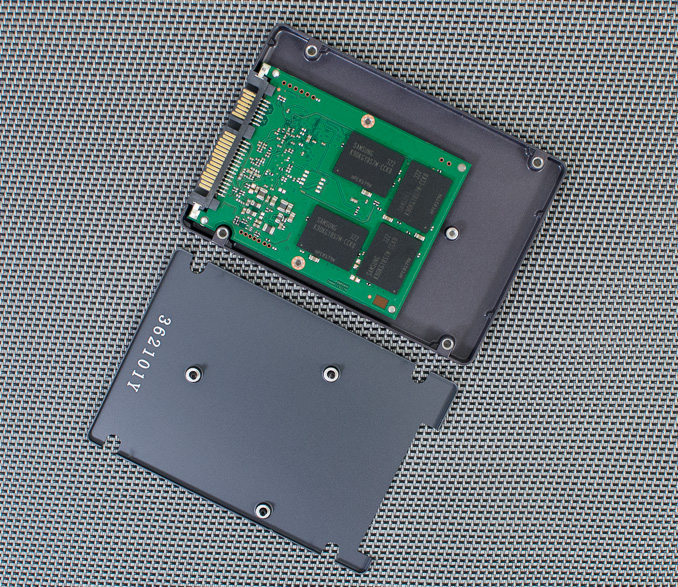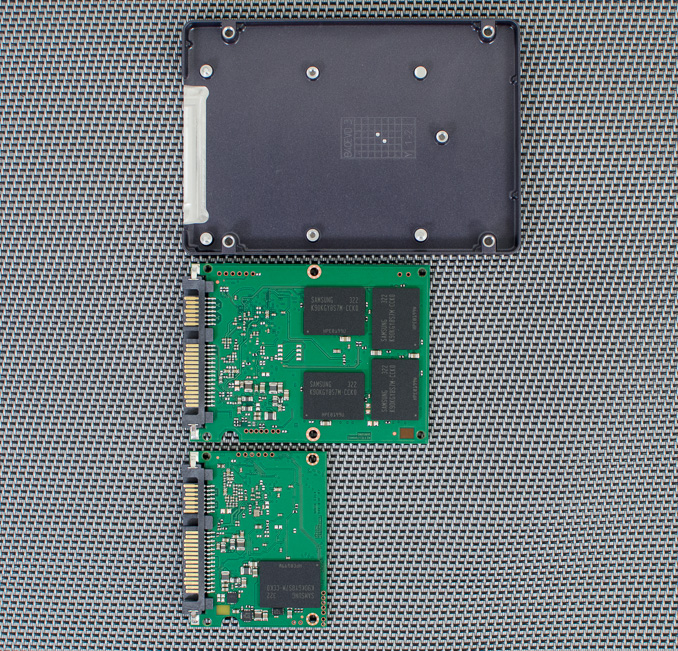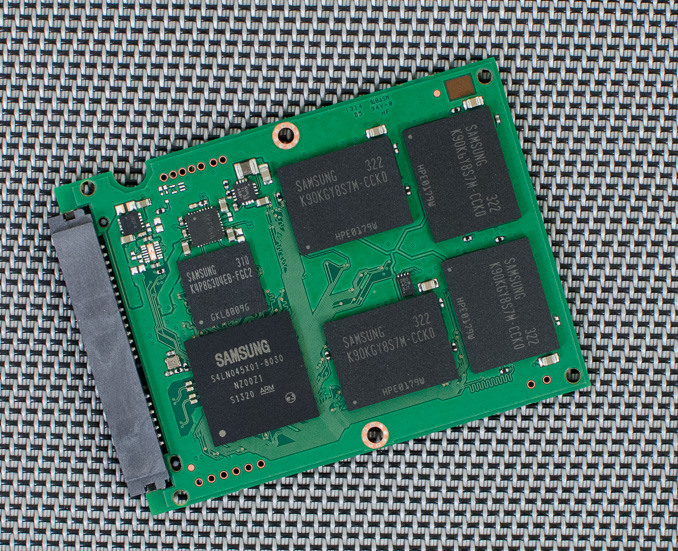Samsung SSD 840 EVO Review: 120GB, 250GB, 500GB, 750GB & 1TB Models Tested
by Anand Lal Shimpi on July 25, 2013 1:53 PM EST- Posted in
- Storage
- SSDs
- Samsung
- TLC
- Samsung SSD 840
Inside the Drives & Spare Area
The EVO is offered in a single form factor - 2.5" at a 7mm thickness. There are three torx (T5) screws that hold the chassis together, removing them gets you a look at the EVO's very simple internals. Surprisingly enough there's no thermal pad between Samsung's MEX controller and the chassis.
Samsung, like Intel, does a great job of reducing the number of screws and simplifying the assembly of its drives. I would prefer if Samsung didn't insist on using torx screws to hold the chassis together but I'm sure it does have some impact on reducing returns. There's also growing concern of counterfit SSDs which I guess screw choice could somewhat address.
There are two PCB sizes used in the EVO lineup, neither of which occupies the full volume of the 2.5"/7mm chassis. The 120 and 250GB drives use the smallest PCB, while the other drives use the larger layout. The larger PCB has room for 8 NAND packages, while the half length PCB can accommodate two. Each of the NAND packages can hold up to 8 x 128Gbit 19nm TLC die.
To deal with the realities of TLC, Samsung sets aside more of the drive for use as spare area on the EVO than it does on its MLC Pro line. Due to TurboWrite however, the percentage is actually a bit less than it was on last year's 840.
| Samsung SSD 840 EVO Memory | |||||||
| Advertised Capacity | 120GB | 250GB | 500GB | 750GB | 1TB | ||
| DRAM Size | 256MB LPDDR2-1066 | 512MB LPDDR2-1066 | 512MB LPDDR2-1066 | 1GB LPDDR2-1066 | 1GB LPDDR2-1066 | ||
| # of NAND Packages | 2 | 2 | 4 | 8 | 8 | ||
| # of NAND die per Package | 4 | 8 | 8 | 4 | 8 | ||
| NAND Capacity per Package | 64 GiB | 128 GiB | 128 GiB | 96 GiB | 128 GiB | ||
| Total NAND | 128 GiB | 256 GiB | 512 GiB | 768 GiB | 1024 GiB | ||
| Spare Area | 12.7% | 9.05% | 9.05% | 9.05% | 9.05% | ||
I've tossed internal shots of all of the EVO lineup into the gallery below:



















137 Comments
View All Comments
Sivar - Thursday, July 25, 2013 - link
Really well-written article.I have to admit, while most of Samsung's products are crap, their 840 and later SSDs are not bad at all.
(The 830, while not prone to electronic failure, was built really poorly. It's SATA connector would snap off if you tilted your head the wrong way while looking at it).
Coup27 - Thursday, July 25, 2013 - link
Samsung have gotten into the world position they are in today by selling crap. I have used plenty of 830's and I have never had an issue with the SATA connector so I have no idea what you are doing with it.Coup27 - Thursday, July 25, 2013 - link
Haven't ^^ (why is there no edit button?)piroroadkill - Thursday, July 25, 2013 - link
So you accidentally broke a SATA connector, and now that's suddenly a flaw? I have two Samsung 830 256GB in my system, and somehow I didn't break the SATA connectors...I also fitted 4x Samsung 830 256GB to a server at work.. and somehow I didn't break the SATA connectors..
HisDivineOrder - Saturday, July 27, 2013 - link
True, this. SATA connectors are poorly designed, but that's the fault of the people who made the spec, not the specific one in the 830. I'm not saying it can't break. I've had SATA connectors break on a variety of devices. None of them were my 830, but I'm not saying it's impossible or whatever.I've seen WD, Seagate, and Hitachi drives all have a problem with the connector, though. Seems like SATA and HDMI were designed to make the connection as loose and easily broken as possible. I guess that gives them some small percentage of people buying all new product to replace something on said product that's small and plastic...
mmaenpaa - Thursday, July 25, 2013 - link
Good article once again Anand,and very good perfomance for this price range.
Regarding Torx, I believe this is one the main reasons why it is used:
"By design, Torx head screws resist cam-out better than Phillips head or slot head screws. Where Phillips heads were designed to cause the driver to cam out, to prevent overtightening, Torx heads were designed to prevent cam-out. The reason for this was the development of better torque-limiting automatic screwdrivers for use in factories. Rather than rely on the tool slipping out of the screw head when a torque level is reached, thereby risking damage to the driver tip, screw head and/or workpiece, the newer driver design achieves a desired torque consistently. The manufacturer claims this can increase tool bit life by ten times or more"
(from https://en.wikipedia.org/wiki/Torx)
BR,
Markku
hybrid2d4x4 - Thursday, July 25, 2013 - link
For what it's worth, my experience with screws is consistent with your post. I've never had a torx screw slip out, which is definitely not the case with philips or the square or flathead varieties. I'd like to see them used more often.piroroadkill - Thursday, July 25, 2013 - link
Agreed. I love Torx. Philips and pozidriv are the terrible bastard children of the screw universe. Always slipping and burring. Ugh. If everything was replaced with totally cam-out free designs like Torx, allen head, robertson screw.. etc, etc.. then I'd be more than happy.psuedonymous - Thursday, July 25, 2013 - link
I'd LOVE for Torx to be used more often. They're much easier to work with (not once have I had a Torx screw fall off the screwdriver and roll under the desk), the screwheads are more robust, and they frankly look a lot nicer than Philips or Pozidriv.It'd make pulling apart laptops all day a darn sight less onerous if Torx were the standard rather than Philips.
camramaan - Friday, February 14, 2014 - link
But then there would be less security in other areas of the mechanical world... not everyone can carry a bunch of Torx bits everywhere they go, so breaking into, or disassembling something built with Torx is more time laborious and pre-planned. I fully understand the sentiments, but the development of alternative screw heads was more for security than ease of use.